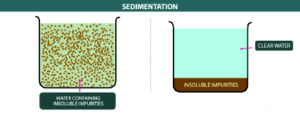Table of Contents
NCERT Solutions for Class 6 Science Chapter 5 Updated for 2024-25
NCERT Solutions for Class 6 Science Chapter 5 Separation of Substances teaches you to solve different kinds of questions that can be asked on the topic included in methods of separation of substances. These NCERT Solutions are available in PDF format for easy access and download. These NCERT solutions study materials are important for your CBSE Class 6 examination. In order to score good marks, we recommend studying the solution thoroughly.
The NCERT Solutions for Class 6 Science is a crucial study source that will help you clear all the doubts that occur while studying the CBSE syllabus Chapter 5 of Class 6 Science. Fill in the blanks, True or false questions, long answer questions and practical based questions and their answers will help you clear the concepts, which are significant from the standpoint of your future studies. Access the PDF of this chapter’s NCERT Solutions for Class 6 Science from the link provided below.
NCERT Solutions for Class 6 Science Chapter 5 PDF Download
In below pdf we have provided NCERT class 6 Science chapter 5 pdf question answer from class 6 science NCERT textbook

NCERT Solutions for Class 6 Science Chapter 5 Question Answer
Here are all the class 6 Science chapter 5 questions answer form NCERT textbook for the year 2024-25
Class 6 Science Chapter 5 Exercise Question Answer Page N0. 44
1. Why do we need to separate different components of a mixture? Give two examples.
Ans: We need to separate different substances present in a mixture due to the following reasons :
- To remove the unuseful or harmful components.
- To obtain the useful components.
- To remove impurities for getting a pure sample.
Eg.
- Tea leaves are separated from liquid with a strainer while preparing tea.
- Grain is separated from stalks, while harvesting.
2. What is winnowing? Where is it used?

Ans :
- Winnowing is used to separate heavier and lighter components of a mixture by wind or
by blowing air. - This method is commonly used by farmers to separate lighter husk particles from
heavier seeds of grain.
3. How will you separate husk or dirt particles from a given sample of pulses before cooking?
Ans: The husk particles or dust particles are separated from pulses by the method of handpicking. The unwanted particles are present in small quantities in the total amount of pulses. So they are separated by handpicking before cooking the pulses.
4. What is sieving? Where is it used?
Ans:
- Sieving allows fine particles to pass through the holes of the sieve, while the bigger
particles like pieces of dust, stone, husk, etc., remain on the sieve. - In a flour mill, impurities are removed from wheat by sieving.
5. How will you separate sand and water from a mixture?
Ans:
A mixture of sand and water can be separated by the sedimentation and decantation methods. Take a glass tumbler half-filled with the given sample of water and stir the water thoroughly. Now keep the tumbler undisturbed for some time. We must see that sand is settled down at the bottom of the tumbler. This process is sedimentation. Now pour the clear water into another tumbler, without disturbing the layer of sand. This process is decantation.
In this way, a mixture of sand and water can be separated.



Fig. Separating two components of a mixture by sedimentation
6. Is it possible to separate sugar mixed with wheat flour? If yes, how will you do it?
Ans: Yes, it is possible to separate sugar mixed with wheat flour. The mixture of sugar and wheat flour can be separated by sieving. The wheat fine particles are separated by the sieve and sugar particles being bigger in size remain on the sieve. Thus, sugar can be separated from the mixture of sugar and wheat flour.
7. How would you obtain clear water from a sample of muddy water?
Ans:
- Muddy water is allowed to stand in a beaker.
- Mud settles at the bottom. It is called sedimentation.
- It is poured into another beaker. It is decantation.
- This water is filtered again to remove small traces of mud particles.
8. Fill up the blanks
Ans :
a) The method of separating seeds of paddy from its stalks is called ___________.
b) When milk, cooled after boiling, is poured onto a piece of cloth the cream (malai) is left behind on it. This process of separating cream from milk is an example of ___________.
c) Salt is obtained from seawater by the process of ___________.
d) Impurities settled at the bottom when muddy water was kept overnight in a bucket. The clear water was then poured off from the top. The process of separation used in this example is called ___________.
Ans :
- Threshing
- Filtration
- Evaporation
- Sedimentation and decantation.
9. True or false?
- A mixture of milk and water can be separated by filtration.
- A mixture of powdered salt and sugar can be separated by the process of winnowing.
- Separation of sugar from tea can be done with filtration.
- Grain and husk can be separated with the process of decantation.
Ans :
- False
- False
- False
- False
10. Lemonade is prepared by mixing lemon juice and sugar in water. You wish to add ice to cool it. Should you add ice to the lemonade before or after dissolving sugar? In which case would it be possible to dissolve more sugar.
Ans:
- We should add ice to the lemonade after dissolving.
- It will be possible to dissolve more sugar before adding ice.
- Because more sugar can be dissolved in a hot solution than in a cool solution.
Note :- Solubility of a solid in liquid increases with an increase in temperature.
- Chapter 1 Food: Where Does It Come From?
- Chapter 2 Components of Food
- Chapter 3 Fibre to Fabric
- Chapter 4 Sorting Materials Into Groups
- Chapter 5 Separation of Substances
- Chapter 6 Changes Around Us
- Chapter 7 Getting to Know Plants
- Chapter 8 Body Movements
- Chapter 9 The Living Organisms and Their Surroundings
- Chapter 10 Motion and Measurement of Distances
- Chapter 11 Light, Shadows, and Reflection
- Chapter 12 Electricity and Circuits
- Chapter 13 Fun with Magnets
- Chapter 14 Water
- Chapter 15 Air Around Us
- Chapter 16 Garbage In, Garbage Out
Class 6 NCERT Solutions for Science Chapter 5 Separation of Substances Overview
Chapter 5 of NCERT Class 6 Science introduces you to methods of separation such as hand-picking, winnowing, threshing, sieving, sedimentation, decantation, filtration and evaporation. The NCERT Solutions for Class 6 Science of this chapter will make you understand the process of separation by using real-life examples, such as separating husk and stones from grains, separation of solids from liquids etc.
Important Topics Discussed in Class 6 Science Chapter 5
- Methods of separation
- Hand-picking
- Winnowing
- Threshing
- Sieving
- Sedimentation, Decantation and Filtration
- Evaporation
- Use of more than one method of separation
- Can water dissolve any amount of a substance?
Students can utilise the NCERT Solutions for Class 6 Science Chapter 5 for any quick references to comprehend these and other complex topics.
Also, students can access the NCERT Solutions for Class 6 of other chapters and subjects for free. These solutions are prepared by well-experienced tutors at Infinity learn focusing on providing clarity on important concepts and problem-solving skills.
Infinity learn provides resource materials such as NCERT Solutions that are prepared by subject experts for free access and download. At Infinity learn, you will also get CBSE notes, NCERT Syllabus, NCERT textbooks, sample papers, extra questions, as well as tips and tricks. To get free access to all the study material we provide, download the Infinity learn learning App.
| Other Resources for Class 6 | |
| Worksheet for Class 6 All subjects | CBSE Notes Class 6 |
| NCERT Books for Class 6 | Online Tuition for Class 6 |
FAQs on NCERT Solutions for Class 6 Science Chapter 5
What is substance separation in Class 6 science?
Substance separation in Class 6 science refers to the process of separating different components or substances from a mixture. This can be achieved through various methods such as handpicking, sieving, winnowing, threshing, sedimentation, decantation, filtration, and evaporation. These techniques help in separating solid-liquid, liquid-liquid, and solid-solid mixtures.
Why do we need substance separation?
Substance separation is essential for several reasons: It helps in obtaining pure substances from a mixture. It is necessary for recycling and reusing materials. Separation methods are used in various industries for the production of goods and services. It is crucial for environmental protection and public health, as it helps in separating waste and pollutants from the environment.
What is the name of Chapter 5 in class 6th science?
Chapter 5 in the NCERT Class 6 Science textbook is titled Separation of Substances.
Can the NCERT Solutions for Class 6 Science Chapter 5 be considered as the repository of important questions?
We at Infinity learn, provide a set of important questions with solutions based on the latest CBSE guidelines. The answers are compiled in the form of a PDF which can be accessed by the students anywhere and at any time. The subject matter experts having vast knowledge about the respective concepts frame the solutions to help students ace the exam. The solutions contain explanations in a simple language which boost the confidence among students in answering the complex questions efficiently.
What are the benefits of referring to the NCERT Solutions for Class 6 Science Chapter 5?
Students who solve the textbook questions referring to the NCERT Solutions for Class 6 Science Chapter 5 find it really helpful during the exams. The solutions are prepared by the experts in an interactive manner which enables students to have a better understanding of the important concepts. By regular practice, students will be able to analyse the type of questions that would appear in the Class 6 exams. The solutions help students to complete the syllabus on time and also focuses on revision a couple of months prior to the exam.
What are the important concepts covered in Chapter 5 of NCERT Solutions for Class 6 Science?
The important concepts covered in Chapter 5 of NCERT Solutions for Class 6 Science are – Methods of separation, Hand-picking, Winnowing, Threshing, Sieving, Sedimentation, Decantation and Filtration, Evaporation, Use of more than one method of separation.
Can water dissolve any amount of a substance?
To understand these concepts in a better way, students can refer to the NCERT Solutions created by the faculty at Infinity learn. The PDF format of solutions is available which can be downloaded and used by the students based on their needs.









